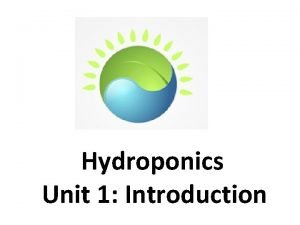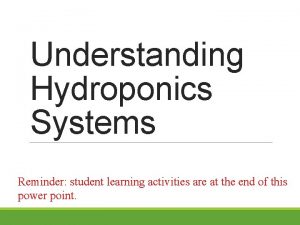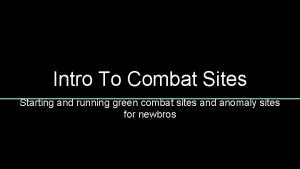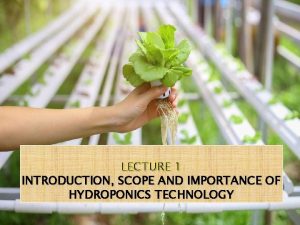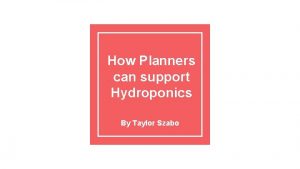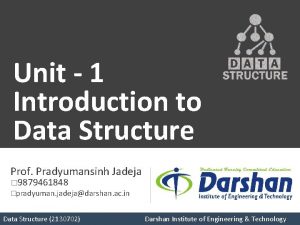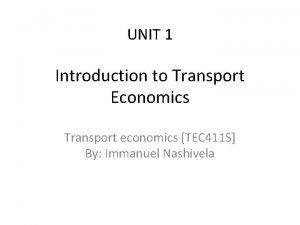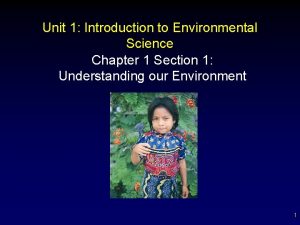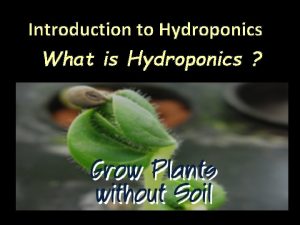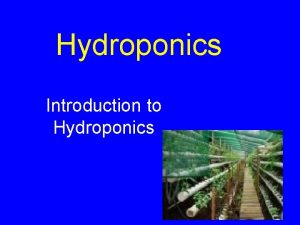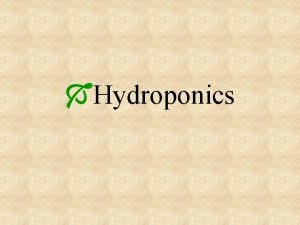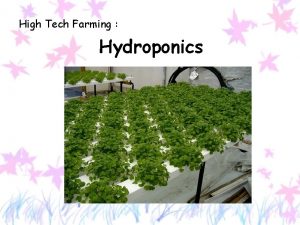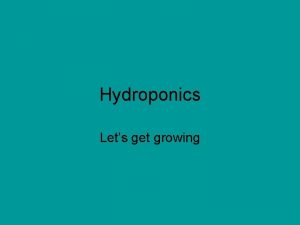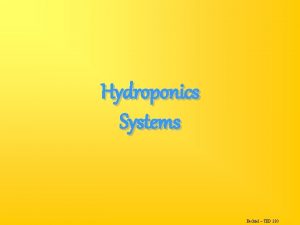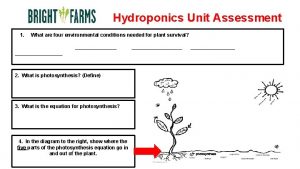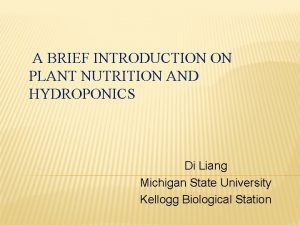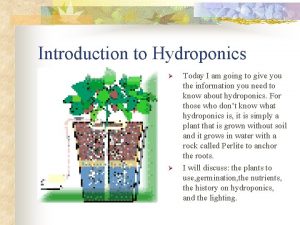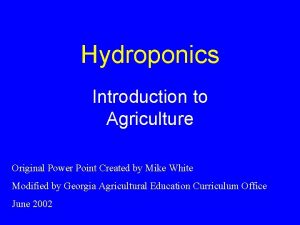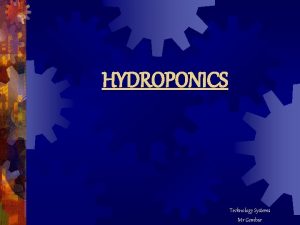Hydroponics Unit 1 Introduction Hydroponics Unit 1 Introduction



















- Slides: 19

Hydroponics Unit 1: Introduction

Hydroponics Unit 1 Introduction Hydroponics is the technique of growing plants without soil. The roots grow either in air, which is kept very humid; in water which is well aerated; or in some solid, non-soil medium, which is kept moist. The water around the roots contains a carefully balanced mixture of nutrients which provides food for the plants

There are three main ways of growing plants hydroponically • Aggregate Culture : where small particles of chemically inert substances provide suitable environment for the plant roots to grow through. • Rockwool culture: a fibrous sponge-like material made from molten rock provides an environment for the roots to grow through. • Water: perhaps mixed with air( with no solid material), provides material for the roots to grow through.

The aggregate, rockwool or water which is used to provide the root environment, supplies the physical needs of the roots. The roots (and in fact the whole plant) also have chemical needs which must be catered to. The chemical needs are supplied by adding a carefully calculated solution of nutrients to the root zone and maintaining the balance of chemicals in that solution at appropriate levels Hydroponics has also been called “soilless culture”, “Nutriculture”, and “Chemiculture”.

An Introduction to Hydroponics

Hydroponics Unit 1: History of hydroponics

https: //www. youtube. com/watch? v=p. ZJWnpz_m. MU

Classifications of Hydroponic Systems There are two main types of Hydroponic systems: Water Culture Nutrients are dissolved in water which is brought in contact with the roots. Water is either aerated or roots are allowed contact air as well as nutrient solution Trellis, wire mesh or some other support is provided above the nutrient solution Examples: • Nutrient Tank • Standard Jar • Nutrient Film (NFT) • Mist System


Aggregate Culture Nutrients are dissolved in water which is moved into the root area. The roots are grown in a solid, inert, (nutrient-free)material, which is able to hold sufficient moisture but drain off the excess, allowing adequate aeration. The solid material which the roots grow in contribute towards (if not fully supplying) anchorage Examples: Bed and Tier systems

The Variables of a systems The types of hydroponic system that can be used vary for a range of reasons. The most common variables are: 1. Solution Dispensation – Closed or Open (i. e. the solution is recycled or drained through and lost) - Drip, capillary feed, wicks, misting 2. Automatic or manual operation 3. Type of medium- gravel, vermiculite, perlite, sand, scoria peat, expanded clay 4. Construction material – concrete, fiberglass, plastic, wood, masonry, metal, PVC, ceramic, polystyrene 5. Rate and frequency of irrigation and feeding 6. Air injection (in water culture, where oxygen is pumped into the nutrient solution to raise the oxygen level) 7. Plant support- trellis 8. Environmental controls- temperature, ventilation

Advantages & Disadvantages of a Hydroponic system Advantages 1. You can grow anywhere- crops can be grown where no suitable soil exist or where soil is contaminated with disease. 2. Culture is intensive – a lot can be grown in a small place, over a short period of time. It is also possible to grow in multi-levels. Where transportation cost to market are significant( i. e. in the center of large cities) Hydroponic farms may be viable irrespective of land values. The savings on transport cost and the benefits of having fresh produce offsets the increased cost of space in these cities. 3. Heavy work is reduced – Labor for tilling the soil, cultivation fumigation watering and other traditional practices can be reduced and sometimes eliminated

4. Water is conserved- a well designed, properly run hydroponic system uses less water than gardening. This is an important advantage in areas with poor quality or limited water supplies. Hydroponic is seen to have potential benefits in controlling water pollution in developing countries. 5. Weed problems are almost eliminated- weeds a major problem in most soil-bases systems. Weed are almost non-existent in hydroponic setups 6. Yields can be maximized- maximum yields are possible making the system economically feasible in high density and expensive land areas.

Advantages 7. Pest& Disease problems are reduced – the need to fumigate is reduced. Soil-borne plant diseases are more easily eradicated in many nutriculture systems. This is particularly true in “closed systems” which can be totally flooded with an eradicant. The chance of soil-borne human disease is also reduced. Though rare in developed countries, it is possible for diseases to be transmitted from animal manures or soil micro-organism onto food plants grown in soil, leading to illness. 8. Nutrients are conserved- this can lead to a reduction in pollution of land stream because valuable chemicals needn’t be lost.

ADVANTAGES 9. The environment is more easily controlled- in a greenhouse operation the light, temperature, humidity, and composition of the atmosphere can be manipulated, while in the root zone the timing of the nutrients can be readily controlled. 10. Root Zone chemistry is easier to control- Salt toxicities can be leached out; p. H can be adjusted; EC (electrocondutivity) can be adjusted. Also salts will not bind chemically to the majority of the media used in hydroponics so problems of salt build-up that may occur in soils. Particularly when highly soluble nutrients are used are uncommon in hydroponics 11. New Plants are easier to establish- transplant shock is reduced

Advantages 12. Crop rotation/Fallowing is not necessary – all areas can be used at all times – you do not have to leave a Paddock/ field for a year to fallow every so often. The amateur Horticulturist can use hydroponic systems at home, even in a high rise building. A hydroponic system can be clean, light weight and mechanized.

Disadvantages 1. Initial cost is high – the original construction cost per hectare is high. This may limit you to growing crops which either have a fast turnover or give high return. 2. Skill and knowledge are needed to operate properly – trained plantsman must direct the growing operation. Knowledge of how plants grow and the principles of nutrition are important. 3. Disease and pest can spread quickly through the system - introduced diseases and nematodes mat be quickly spread to all beds using the same nutrient tank in a closed system.

Disadvantages 4. Beneficial soil life is normally absent 5. Plant react fast to good and bad conditions – the plants in a hydroponics react more quickly to changes in growing conditions. This means that the hydroponic gardener needs to watch his/her plant more closely for changes. 6. Availability of plant varieties are not always ideal – most available plant varieties have been developed for growth in soil in the open. Development of varieties which are specifically adapted to more control conditions may be slow to occur

“I would hope that we can move along a continuum to make sure that all of the citizens have access to the same fresh, safe, affordable foods regardless of their cultural, social, or economic situation" ~ Will Allen https: //www. youtube. com/watch? v=j. V 9 CCxdk. Ong&feature=youtu. be [1 MILLION pounds of Food on 3 acres. 10, 000 fish 500 yards compost ] https: //www. youtube. com/watch? v=K 5 z. P 4 WPgcq. Y [Will Allen [Urban Farmer] - Growing Power ] https: //www. youtube. com/watch? v=ux 69 G 4_qbf 0 [Will Allen - Speaking at JHSPH ]
 Introduction of hydroponics
Introduction of hydroponics Hydroponics worksheet answers
Hydroponics worksheet answers Serpentis forsaken hideaway
Serpentis forsaken hideaway Importance of hydroponics
Importance of hydroponics Space engineers hydroponics
Space engineers hydroponics Taylor szabo
Taylor szabo Unit 6 review questions
Unit 6 review questions Body paragraph structure
Body paragraph structure Diff between primitive and nonprimitive
Diff between primitive and nonprimitive Unit 1 introduction to accounting
Unit 1 introduction to accounting Whats your name bob
Whats your name bob Unit 1 introduction to logistics
Unit 1 introduction to logistics Unit 1 introduction to accounting
Unit 1 introduction to accounting Unit 1 economics
Unit 1 economics Renaissance 1485 to 1660
Renaissance 1485 to 1660 The middle ages 1066 to 1485 unit introduction
The middle ages 1066 to 1485 unit introduction Locard's exchange principle
Locard's exchange principle Unit 1 introduction to environmental science
Unit 1 introduction to environmental science Unit 1 introduction to economics
Unit 1 introduction to economics Unit 1 introduction to psychology
Unit 1 introduction to psychology
